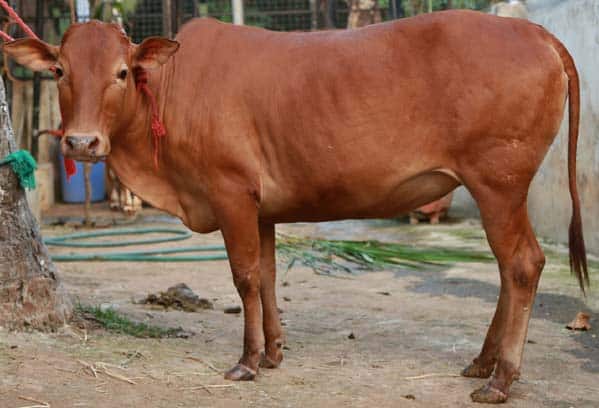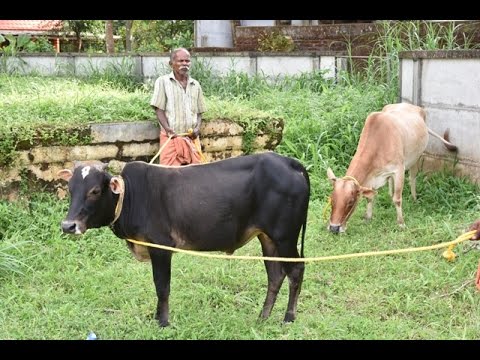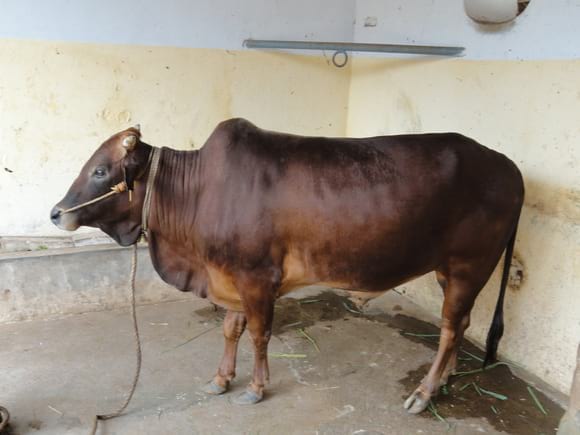
Vechur
Vechur cattle
Vechur cattle are the small breed of Indian cattle. They are mostly light red or black in colour with a long and narrow face. The legs are short with long and tapering tail, almost touching the ground. The Vechur cattle are active and strong animals. The cows are very good milk producers, producing up to 3 liters of milk a day. They require less care, feed, and maintenance. Milk of the Vechur cows is believed to have medicinal qualities, and milk is easy to digest due to smaller fat globule size. The bulls are strong compared to their body size and previously used for work.

Fig. 1: Vechur Small Cow
The Vechur (family: Bos indicus) is a rare breed of cattle named after the village Vechoor in Kottayam district of Kerala in India. It is the smallest cattle breed in the world according to the Guinness Book of Records with an average length of 124 cm and a height of 87 cm and is valued for the larger amount of milk it produces relative to the amount of food it requires.
The Vechur cow was popular in Kerala until the 1960s but became rare when native cattle were crossbred with exotic varieties. In 1989, a conservation unit was started and Vechur animals were saved from extinction by conservation efforts of Sosamma Iype, a Professor of animal genetics and breeding along with a team of her students. Later in 1998, a Conservation Trust was formed to continue the work with farmer participation. In 2000, the Vechur cow was listed on the FAO’s World Watch List of Domestic Animal Diversity, in its ‘Critical-Maintained Breeds List’, pointing to imminent extinction as breeds are included in the list when the number of breeding females and males fall to very low levels. About 200 cows are supposed to exist today, nearly 100 of them with the Veterinary College.
Read more info about this cattle breed below.
(Video Credit : Pradeep S)
Characteristics:
Their color may vary and can be any but mostly light red or black in colour with a long and narrow face. Both cows and bulls have horns that are small and curved backward. The breed averages about 90 cm in height and weighs around 130 kg, yielding up to 3 liters of milk a day. This is much less than that of the hybrid varieties but, unlike them, the Vechur cow also requires little by way of feed or maintenance. The milk is believed to have medicinal qualities and easy digestibility due to smaller fat globule size. A recent report claims that the milk of the Vechur cow has more of the beta casein variety A2, rather than the variety A1 which is implicated in conditions like diabetes, ischaemic heart disease, and autism.

Fig. 2: Vechur Bull
The medicinal property of the Vechur cow’s milk has been documented traditionally by Ayurveda and recent scientific studies have substantiated this. The protein component of the Vechur cow’s milk has an improved antimicrobial property. As per recent findings, the antibacterial property of the lactoferrin protein present in the Vechur Cow milk is more than that of the antibiotic ampicillin. Although lactoferrin found to have antimicrobial, antiviral, antitumor, immunodefence and anti-inflammatory properties and recent studies proves that these properties are much more enhanced in the Vechur cow milk. The Vechur Ghee (clarified butter) produced from Vechur cow’s milk, is famous for its high medicinal values due to the presence of A2 beta-lactalbumin protein and higher arginine content which is good for the health of convalescing people.

Fig. 3: Vechur Cow
References:
https://en.wikipedia.org/wiki/Vechur_Cattle
https://www.youtube.com/channel/UCQyU0ijUBlFH4doHIMpY9ug
